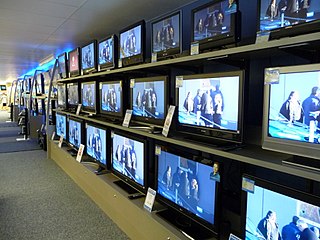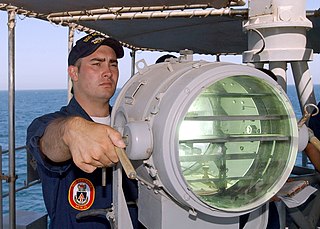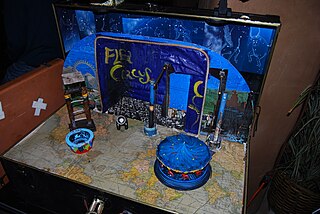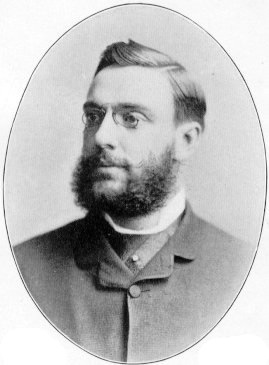
Alexander Graham Bell was a Scottish-born Canadian-American inventor, scientist and engineer who is credited with patenting the first practical telephone. He also co-founded the American Telephone and Telegraph Company (AT&T) in 1885.

Television (TV) is a telecommunication medium for transmitting moving images and sound. Additionally, the term can refer to a physical television set, rather than the medium of transmission. Television is a mass medium for advertising, entertainment, news, and sports. The medium is capable of more than "radio broadcasting", which refers to an audio signal sent to radio receivers.

John Logie Baird was a Scottish inventor, electrical engineer, and innovator who demonstrated the world's first live working television system on 26 January 1926. He went on to invent the first publicly demonstrated colour television system and the first viable purely electronic colour television picture tube.

The photophone is a telecommunications device that allows transmission of speech on a beam of light. It was invented jointly by Alexander Graham Bell and his assistant Charles Sumner Tainter on February 19, 1880, at Bell's laboratory at 1325 L Street in Washington, D.C. Both were later to become full associates in the Volta Laboratory Association, created and financed by Bell.

Optical communication, also known as optical telecommunication, is communication at a distance using light to carry information. It can be performed visually or by using electronic devices. The earliest basic forms of optical communication date back several millennia, while the earliest electrical device created to do so was the photophone, invented in 1880.

Antonio Santi Giuseppe Meucci was an Italian inventor and an associate of Giuseppe Garibaldi, a major political figure in the history of Italy. Meucci is best known for developing a voice-communication apparatus that several sources credit as the first telephone.

Nathan Beverly Stubblefield was an American inventor best known for his wireless telephone work. Self-described as a "practical farmer, fruit grower and electrician", he received widespread attention in early 1902 when he gave a series of public demonstrations of a battery-operated wireless telephone, which could be transported to different locations and used on mobile platforms such as boats. While this initial design employed conduction, in 1908 he received a U.S. patent for a wireless telephone system that used magnetic induction. However, he was ultimately unsuccessful in commercializing his inventions. He later went into seclusion, and died alone in 1928.

Alfred Ely Beach was an American inventor, entrepreneur, publisher, and patent lawyer, born in Springfield, Massachusetts. He is known for his design of the earliest predecessor to the New York City Subway, the Beach Pneumatic Transit, which became the first subway in America. He was an early owner and cofounder of Scientific American and Munn & Co., the country's leading patent agency, and helped secure patents for Thomas Edison, Alexander Graham Bell, Cornelius Vanderbilt, and other innovators. A member of the Union League of New York, he also invented a typewriter for the blind and a system for heating water with solar power.

A flea circus is a circus sideshow attraction in which fleas are attached to miniature carts and other items, and encouraged to perform circus acts within a small housing.

Charles Sumner Tainter was an American scientific instrument maker, engineer and inventor, best known for his collaborations with Alexander Graham Bell, Chichester Bell, Alexander's father-in-law Gardiner Hubbard, and for his significant improvements to Thomas Edison's phonograph, resulting in the Graphophone, one version of which was the first Dictaphone.

Jan Szczepanik was a Polish inventor, with several hundred patents and over 50 discoveries to his name, many of which are still applied today, especially in the motion picture industry, as well as in photography and television. Some of his concepts helped the future evolution of TV broadcasting, such as the telectroscope or the wireless telegraph, which greatly affected the development of telecommunications. He died in Tarnów in the Second Polish Republic.

The invention of the telephone was the culmination of work done by more than one individual, and led to an array of lawsuits relating to the patent claims of several individuals and numerous companies. Notable people including in this were Antonio Meucci, Elisha Gray and Alexander Graham Bell.

The Movietone sound system is an optical sound-on-film method of recording sound for motion pictures that guarantees synchronization between sound and picture. It achieves this by recording the sound as a variable-density optical track on the same strip of film that records the pictures. The initial version was capable of a frequency response of 8500 Hz. Although modern sound films use variable-area tracks instead, modern motion picture theaters can play a Movietone film without modification to the projector. Movietone was one of four motion picture sound systems under development in the U.S. during the 1920s, the others being DeForest Phonofilm, Warner Brothers' Vitaphone, and RCA Photophone, though Phonofilm was principally an early version of Movietone.
The Elisha Gray and Alexander Graham Bell controversy concerns the question of whether Gray and Bell invented the telephone independently. This issue is narrower than the question of who deserves credit for inventing the telephone, for which there are several claimants.

George R. Carey (1851–1906) was an American inventor. He was among the first to propose the telectroscope using the photoelectric properties of selenium as a means for transmitting images—a precursor to modern television.

Telecommunications engineering is a subfield of electronics engineering which seeks to design and devise systems of communication at a distance. The work ranges from basic circuit design to strategic mass developments. A telecommunication engineer is responsible for designing and overseeing the installation of telecommunications equipment and facilities, such as complex electronic switching system, and other plain old telephone service facilities, optical fiber cabling, IP networks, and microwave transmission systems. Telecommunications engineering also overlaps with broadcast engineering.

The Volta Laboratory and the Volta Bureau were created in Georgetown, Washington, D.C., by Alexander Graham Bell.
Paul St George is a London based multimedia artist and sculptor, best known for The Telectroscope, an art installation visually linking London and New York.

Thomas Augustus Watson was an assistant to Alexander Graham Bell, notably in the invention of the telephone in 1876.
Videotelephony as a concept began to materialize shortly after the telephone was patented in 1876, and its history is closely connected to that of the telephone.





















